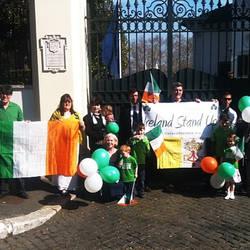Irish Movement Visiting Rome Presses Government to Re-Open Embassy to the Holy See
By Gerard O'Connell
Members of the Ireland Stand Up movement, visiting Rome for St Patrick's Day, re-issued their call to the Irish Government to re-open its Embassy to the Holy See and invite Pope Benedict XVI to visit the country Standing in front of the former Irish Embassy to the Holy See in Rome on March 17, the feast of Saint Patrick, sixteen members of the dynamic Ireland Stand Up movement re-issued their call to the Dublin Government to re-open its embassy to the Holy See, reinstate a resident ambassador, and invite Pope Benedict to visit the country. Led by Mary Fitzgibbon, these Irish lay men, women and children stood in front of the Villa Spada on the Janiculum Hill on the afternoon of Saint Patrick's Day, to keep up the pressure on the Government. Ireland has had diplomatic relations with the Holy See since 1929 and the Villa Spada has been the seat of its embassy for the past 65 years until the Dublin Government decided to close it on 3 November 2011 for economic reasons, though many believe the rationale was more political than economic. The group travelled to Rome for the feast of St Patrick – the apostle of the Irish nation, to press home their case from the site of the former embassy. Their visit coincided with a totally distinct initiative: the arrival in the eternal city of the Eucharistic Congress Bell, which has been taken to parishes throughout the country over the past twelve months in preparation for the 50th International Eucharistic Congress which will be held in Dublin, June 10-17 Archbishop Diarmuid Martin of Dublin and a Congress delegation brought the Bell to Pope Benedict on March 14, who blessed it and rang it vigorously to call people across the world to Ireland for the big event. "The Pope joined the ranks of an estimated quarter of a million Irish pilgrims who have so far rung the bell in a symbolic gesture calling for renewal in the Irish church", the Irish Times reported. The bell was taken into Saint Peter's Basilica that same day and was transported from there to St Isidore's – the Irish Franciscan College, where the Irish community in Rome celebrated St Patrick's Day this year. The representatives of Ireland Stand Up also joined in the celebrations, at which the Irish Government was represented by Pat Rabbitte, Minister for Communications, Energy and Natural Resources. The Ireland Stand Up movement is an entirely lay initiative. It was launched on November 28 with the twin goals of getting the Government to rescind its decision regarding the embassy and resident ambassador, and to officially invite Pope Benedict to Ireland for the Eucharistic Congress in June. Anne Long, one of the sixteen who travelled to Rome, was the inspiration behind the movement. She was the first to express the idea that the Irish people should not accept the Government's decision. This mother of four and secondary school teacher in Dublin told me in Rome, March 16, that she was deeply upset by the decision. "It was a step too far", she stated. "I saw the Embassy's closure as a first step in a bigger ideological program that is part of a secular agenda to remove God from society", she said. Others shared her view, including Mary Fitzgibbon, a lecturer at the Institute of Technology in Tralee, County Kerry. A highly articulate, media-savvy mother of three, Fitzgibbon soon emerged as the strategist and spokeswoman of a surprisingly successful nationwide campaign. Mary, Anne and other lay men and women launched the campaign, using the press and especially the social media, and it quickly gathered momentum. "When we started we didn't know it would become a national campaign, we just wanted to do something", Anne recalled. "It resonated immediately with ordinary people who up to that moment had felt powerless, alone", Mary added. Soon hundreds of lay people from all over the country, and from across the political spectrum, angry at the Government's decision, contacted them and expressed a willingness to lobby their local members of parliament. The clergy kept their distance and didn't join the campaign. One bishop told Fitzgibbon that in the present climate in Ireland it was better that lay people ran this campaign, "because the bishops and priests will only get laughed at if they get involved". From the beginning the campaigners adopted a non-aggressive, respectful style in their public statements and individual approaches, as they actively lobbied their local members of parliament. The success of the campaign took the coalition Government, led by Enda Kenny, by surprise and rattled the political parties, so much so that when the Group called a meeting at Boswell's Hotel, Dublin, on January 18 to brief members of parliament (The Oireachtas), one third of the parliamentarians attended - 61 from the lower house (The Dail), 14 from the upper house (The Seanad) and 6 government representatives. Those parliamentarians expressed overwhelming support for the group’s aims: to get the Government to reverse its decision, and to re-open the embassy, reinstate a resident ambassador, and send an invitation to Pope Benedict to visit the country for the Eucharistic Congress in June. On February 21, Fitzgibbon and two other leaders of the Group presented their case before the parliament’s important Joint Committee for Foreign Affairs and came away with the understanding that the decision to close the embassy would indeed be reviewed. They came to Rome “to keep the issue alive and on the political agenda until our twin aims are met”, Fitzgibbon told me. While they now recognize that Pope Benedict will not come to Ireland for the Eucharistic Congress, nevertheless they want the Government to formally invite him and hope he might take up the invitation in 2013.
|
.
Any original material on these pages is copyright © BishopAccountability.org 2004. Reproduce freely with attribution.
